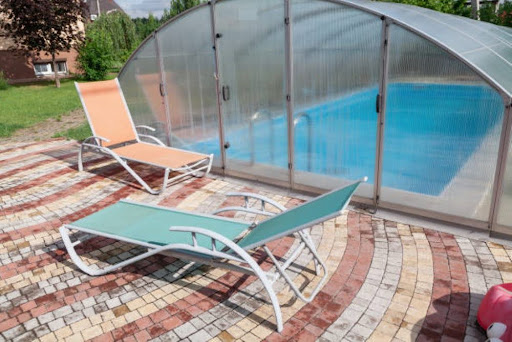Owning a swimming pool is a luxury that offers endless hours of relaxation and fun, especially during the hot summer months.
However, ensuring the safety, cleanliness, and longevity of your pool requires thoughtful consideration and investment in protective measures. This is where pool covers and enclosures come into play.
Types of Pool Covers
- Manual Pool Covers
Manual pool covers are operated by hand, typically using a crank mechanism or pulling system. They provide an affordable option for pool owners seeking basic protection and are relatively easy to install.
- Automatic Pool Covers
Automatic pool covers offer convenience and efficiency, automatically opening and closing with the push of a button. They provide superior safety and insulation, but tend to be more expensive than manual covers.
- Solar Pool Covers
Solar pool covers harness the power of the sun to heat your pool water and reduce evaporation. They are environmentally friendly and cost-effective, helping to extend the swimming season while saving on heating costs.
Benefits of Using Pool Covers
- Safety
One of the primary benefits of pool covers is safety. They act as a barrier, preventing unauthorized access by children and pets, reducing the risk of accidents and drowning.
- Energy Efficiency
Pool covers help to retain heat within the pool, reducing the need for constant heating. This translates to significant energy savings and a lower environmental impact.
- Maintenance
By keeping debris out of the pool, covers minimize the need for cleaning and maintenance. This not only saves time and effort but also prolongs the lifespan of pool equipment and reduces chemical usage.
Types of Pool Enclosures
- Retractable Pool Enclosures
A retractable pool enclosure offer versatility, allowing you to open or close the enclosure as desired. They provide protection from the elements while maintaining an open-air feel during warmer weather.
- Fixed Pool Enclosures
Fixed pool enclosures are permanent structures that provide year-round protection from inclement weather and debris. They create a comfortable indoor environment for swimming, regardless of external conditions.
- Temporary Pool Enclosures
Temporary pool enclosures are lightweight and easy to install, offering temporary protection during specific seasons or events. They are ideal for pool owners looking for a budget-friendly solution or seasonal coverage.
Advantages of Pool Enclosures
- Extend Swimming Season
Pool enclosures help to extend the swimming season by providing insulation and protection from cold weather. This allows you to enjoy your pool for a longer period each year, maximizing its use and value.
- Reduce Maintenance
By keeping out leaves, dirt, and insects, pool enclosures minimize the need for cleaning and maintenance. This saves time and money while ensuring a clean and inviting swimming environment.
- Enhanced Aesthetic Appeal
Pool enclosures come in a variety of styles and designs, allowing you to customize the look of your pool area. Whether you prefer a sleek modern design or a traditional aesthetic, there is an enclosure to suit your preferences.
Factors to Consider When Choosing Pool Covers and Enclosures
- Pool Size and Shape
The size and shape of your pool will dictate the type and size of cover or enclosure needed. It’s essential to measure your pool accurately and consider any unique features or obstacles that may impact installation.
- Budget
Pool covers and enclosures vary widely in price, so it’s essential to establish a budget before beginning your search. Consider the long-term savings and benefits of higher-quality options when making your decision.
- Climate
Your local climate will influence the type of cover or enclosure that is most suitable for your needs. For example, if you live in an area with harsh winters, you may require a more robust enclosure to withstand snow and ice.
- Personal Preferences
Ultimately, the choice of pool cover or enclosure comes down to personal preference. Consider factors such as design, functionality, and ease of use when making your selection.
Installation and Maintenance Tips
- Proper Installation Guidelines
Follow the manufacturer’s instructions carefully when installing your pool cover or enclosure to ensure proper functionality and safety. If in doubt, consult a professional installer to avoid costly mistakes.
- Routine Maintenance Practices
Regularly inspect your pool cover or enclosure for signs of wear and tear, and make any necessary repairs promptly. Keep the surface clean and free of debris to prolong its lifespan and maintain optimal performance.
Conclusion
In conclusion, pool covers and enclosures are essential investments for any pool owner looking to enhance safety, energy efficiency, and overall enjoyment. Whether you opt for a manual cover, automatic cover, or retractable enclosure, the benefits are undeniable. By carefully considering your needs and preferences, you can choose the perfect solution to protect and beautify your pool for years to come.
FAQs
1. Are pool covers and enclosures difficult to install?
Installing pool covers and enclosures can vary in complexity depending on the type and size. Manual covers are generally easier to install, while larger enclosures may require professional assistance.
2. Do pool covers really save on energy costs?
Yes, pool covers help to retain heat within the pool, reducing the need for constant heating. This can result in significant energy savings over time.
3. Are pool enclosures customizable?
Yes, many pool enclosures can be customized to fit your specific requirements, including size, design, and features.
4. Do pool covers and enclosures require maintenance?
Yes, routine maintenance is essential to ensure the longevity and performance of pool covers and enclosures. This may include cleaning, inspection, and minor repairs as needed.
5. Can pool covers and enclosures withstand harsh weather conditions?
Yes, high-quality pool covers and enclosures are designed to withstand a variety of weather conditions, including wind, rain, and snow.






